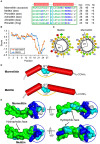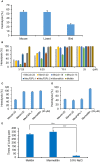Mesobuthus Venom-Derived Antimicrobial Peptides Possess Intrinsic Multifunctionality and Differential Potential as Drugs
- PMID: 29599756
- PMCID: PMC5863496
- DOI: 10.3389/fmicb.2018.00320
Mesobuthus Venom-Derived Antimicrobial Peptides Possess Intrinsic Multifunctionality and Differential Potential as Drugs
Abstract
Animal venoms are a mixture of peptides and proteins that serve two basic biological functions: predation and defense against both predators and microbes. Antimicrobial peptides (AMPs) are a common component extensively present in various scorpion venoms (herein abbreviated as svAMPs). However, their roles in predation and defense against predators and potential as drugs are poorly understood. Here, we report five new venom peptides with antimicrobial activity from two Mesobuthus scorpion species. These α-helical linear peptides displayed highly bactericidal activity toward all the Gram-positive bacteria used here but differential activity against Gram-negative bacteria and fungi. In addition to the antibiotic activity, these AMPs displayed lethality to houseflies and hemotoxin-like toxicity on mice by causing hemolysis, tissue damage and inducing inflammatory pain. Unlike AMPs from other origins, these venom-derived AMPs seem to be unsuitable as anti-infective drugs due to their high hemolysis and low serum stability. However, MeuTXKβ1, a known two-domain Mesobuthus AMP, is an exception since it exhibits high activity toward antibiotic resistant Staphylococci clinical isolates with low hemolysis and high serum stability. The findings that the classical AMPs play predatory and defensive roles indicate that the multifunctionality of scorpion venom components is an intrinsic feature likely evolved by natural selection from microbes, prey and predators of scorpions. This definitely provides an excellent system in which one can study how a protein adaptively evolves novel functions in a new environment. Meantimes, new strategies are needed to remove the toxicity of svAMPs on eukaryotic cells when they are used as leads for anti-infective drugs.
Keywords: Staphylococci; defense; peptide antibiotics; predation; venom gland immunity.
Figures










Similar articles
-
Meucin-49, a multifunctional scorpion venom peptide with bactericidal synergy with neurotoxins.Amino Acids. 2018 Aug;50(8):1025-1043. doi: 10.1007/s00726-018-2580-0. Epub 2018 May 16. Amino Acids. 2018. PMID: 29770866
-
Structural and functional characterization of two genetically related meucin peptides highlights evolutionary divergence and convergence in antimicrobial peptides.FASEB J. 2009 Apr;23(4):1230-45. doi: 10.1096/fj.08-122317. Epub 2008 Dec 16. FASEB J. 2009. PMID: 19088182
-
Two new cationic α-helical peptides identified from the venom gland of Liocheles australasiae possess antimicrobial activity against methicillin-resistant staphylococci.Toxicon. 2021 Jun;196:63-73. doi: 10.1016/j.toxicon.2021.04.002. Epub 2021 Apr 6. Toxicon. 2021. PMID: 33836178
-
Animal Venom Peptides: Potential for New Antimicrobial Agents.Curr Top Med Chem. 2017;17(10):1119-1156. doi: 10.2174/1568026616666160930151242. Curr Top Med Chem. 2017. PMID: 27697042 Review.
-
Scorpion Venom Peptides as a Potential Source for Human Drug Candidates.Protein Pept Lett. 2018;25(7):702-708. doi: 10.2174/0929866525666180614114307. Protein Pept Lett. 2018. PMID: 29921194 Review.
Cited by
-
A Critical Review of Short Antimicrobial Peptides from Scorpion Venoms, Their Physicochemical Attributes, and Potential for the Development of New Drugs.J Membr Biol. 2024 Aug;257(3-4):165-205. doi: 10.1007/s00232-024-00315-2. Epub 2024 Jul 11. J Membr Biol. 2024. PMID: 38990274 Free PMC article. Review.
-
Development of chimeric peptides to facilitate the neutralisation of lipopolysaccharides during bactericidal targeting of multidrug-resistant Escherichia coli.Commun Biol. 2020 Jan 23;3(1):41. doi: 10.1038/s42003-020-0761-3. Commun Biol. 2020. PMID: 31974490 Free PMC article.
-
Venomics of Scorpion Ananteris platnicki (Lourenço, 1993), a New World Buthid That Inhabits Costa Rica and Panama.Toxins (Basel). 2024 Jul 23;16(8):327. doi: 10.3390/toxins16080327. Toxins (Basel). 2024. PMID: 39195737 Free PMC article.
-
Inhibition of bacterial biofilms by the snake venom proteome.Biotechnol Rep (Amst). 2023 Aug 1;39:e00810. doi: 10.1016/j.btre.2023.e00810. eCollection 2023 Sep. Biotechnol Rep (Amst). 2023. PMID: 37559690 Free PMC article.
-
Examining the interactions scorpion venom peptides (HP1090, Meucin-13, and Meucin-18) with the receptor binding domain of the coronavirus spike protein to design a mutated therapeutic peptide.J Mol Graph Model. 2021 Sep;107:107952. doi: 10.1016/j.jmgm.2021.107952. Epub 2021 Jun 3. J Mol Graph Model. 2021. PMID: 34119951 Free PMC article.
References
-
- Arpornsuwan T., Buasakul B., Jaresitthikunchai J., Roytrakul S. (2014). Potent and rapid antigonococcal activity of the venom peptide BmKn2 and its derivatives against different Maldi biotype of multidrug-resistant Neisseria gonorrhoeae. Peptides 53, 315–320. 10.1016/j.peptides.2013.10.020 - DOI - PubMed
LinkOut - more resources
Full Text Sources
Other Literature Sources
Molecular Biology Databases

